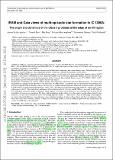Files in this item
IRAM and Gaia views of multi-episodic star formation in IC 1396A : the origin and dynamics of the Class 0 protostar at the edge of an HII region
Item metadata
| dc.contributor.author | Sicilia-Aguilar, Aurora | |
| dc.contributor.author | Patel, Nimesh | |
| dc.contributor.author | Fang, Min | |
| dc.contributor.author | Roccatagliata, Veronica | |
| dc.contributor.author | Getman, Konstantin | |
| dc.contributor.author | Goldsmith, Paul | |
| dc.date.accessioned | 2019-02-19T11:30:09Z | |
| dc.date.available | 2019-02-19T11:30:09Z | |
| dc.date.issued | 2019-02-07 | |
| dc.identifier | 257792936 | |
| dc.identifier | a0da9eec-1bd3-477c-a0dc-6288e3f1b434 | |
| dc.identifier | 000458001800002 | |
| dc.identifier | 85061368736 | |
| dc.identifier | 000458001800002 | |
| dc.identifier.citation | Sicilia-Aguilar , A , Patel , N , Fang , M , Roccatagliata , V , Getman , K & Goldsmith , P 2019 , ' IRAM and Gaia views of multi-episodic star formation in IC 1396A : the origin and dynamics of the Class 0 protostar at the edge of an HII region ' , Astronomy & Astrophysics , vol. 622 , A118 . https://doi.org/10.1051/0004-6361/201833207 | en |
| dc.identifier.issn | 1432-0746 | |
| dc.identifier.uri | https://hdl.handle.net/10023/17093 | |
| dc.description.abstract | Context. IC 1396A is a cometary globule that contains the Class 0 source IC 1396A-PACS-1, which was discovered with Herschel. Aims. We use IRAM 30m telescope and Gaia DR2 data to explore the star formation history of IC 1396A and investigate the possibilities of triggered star formation. Methods. IRAM and Herschel continuum data were used to obtain dust temperature and column density maps. Heterodyne data reveal the velocity structure of the gas. Gaia DR2 proper motions for the stars complete the kinematics of the region. Results. IC 1396A-PACS-1 presents molecular emission similar to a hot corino with warm carbon chain chemistry due to the UV irradiation. The source is embedded in a dense clump surrounded by gas at velocities that are significantly different from the velocities of the Tr 37 cluster. CN emission reveals photoevaporation, while continuum data and high-density tracers ((CO)-O-18, HCO, DCO+, and N2D+) reveal distinct gaseous structures with a range of densities and masses. Conclusions. By combining the velocity, column density, and temperature information and Gaia DR2 kinematics, we confirm that the globule has experienced various episodes of star formation. IC 1396A-PACS-1 is probably the last intermediate-mass protostar that will form within IC 1396A; it shows evidence of being triggered by radiation-driven implosion. Chemical signatures such as CCS place IC 1396A-PACS-1 among the youngest known protostars. Gaia DR2 data reveal velocities in the plane of the sky similar to 4 km s(-1) for IC 1396A with respect to Tr 37. The total velocity difference (8 km s(-1)) between the Tr 37 cluster and IC 1396A is too small for IC 1396A to have undergone substantial rocket acceleration, which imposes constraints on the distance to the ionizing source in time and the possibilities of triggered star formation. The three stellar populations in the globule reveal that objects located within relatively close distances ( | |
| dc.format.extent | 27 | |
| dc.format.extent | 12046820 | |
| dc.language.iso | eng | |
| dc.relation.ispartof | Astronomy & Astrophysics | en |
| dc.subject | Stars: protostars | en |
| dc.subject | Photon-dominated region | en |
| dc.subject | Stars: individual: IC 1396A-PACS-1 | en |
| dc.subject | Stars: individual: HD 206267 | en |
| dc.subject | Open clusters and associations: individual: Tr37 | en |
| dc.subject | Molecular data | en |
| dc.subject | QB Astronomy | en |
| dc.subject | QC Physics | en |
| dc.subject | 3rd-DAS | en |
| dc.subject.lcc | QB | en |
| dc.subject.lcc | QC | en |
| dc.title | IRAM and Gaia views of multi-episodic star formation in IC 1396A : the origin and dynamics of the Class 0 protostar at the edge of an HII region | en |
| dc.type | Journal article | en |
| dc.contributor.institution | University of St Andrews. School of Physics and Astronomy | en |
| dc.identifier.doi | https://doi.org/10.1051/0004-6361/201833207 | |
| dc.description.status | Peer reviewed | en |
| dc.identifier.url | https://arxiv.org/abs/1812.07282 | en |
This item appears in the following Collection(s)
Items in the St Andrews Research Repository are protected by copyright, with all rights reserved, unless otherwise indicated.

